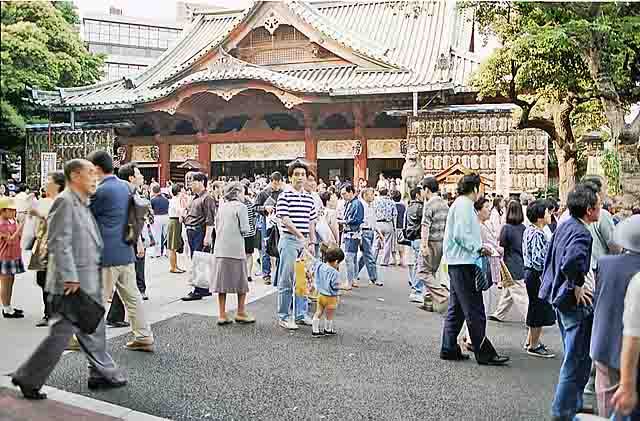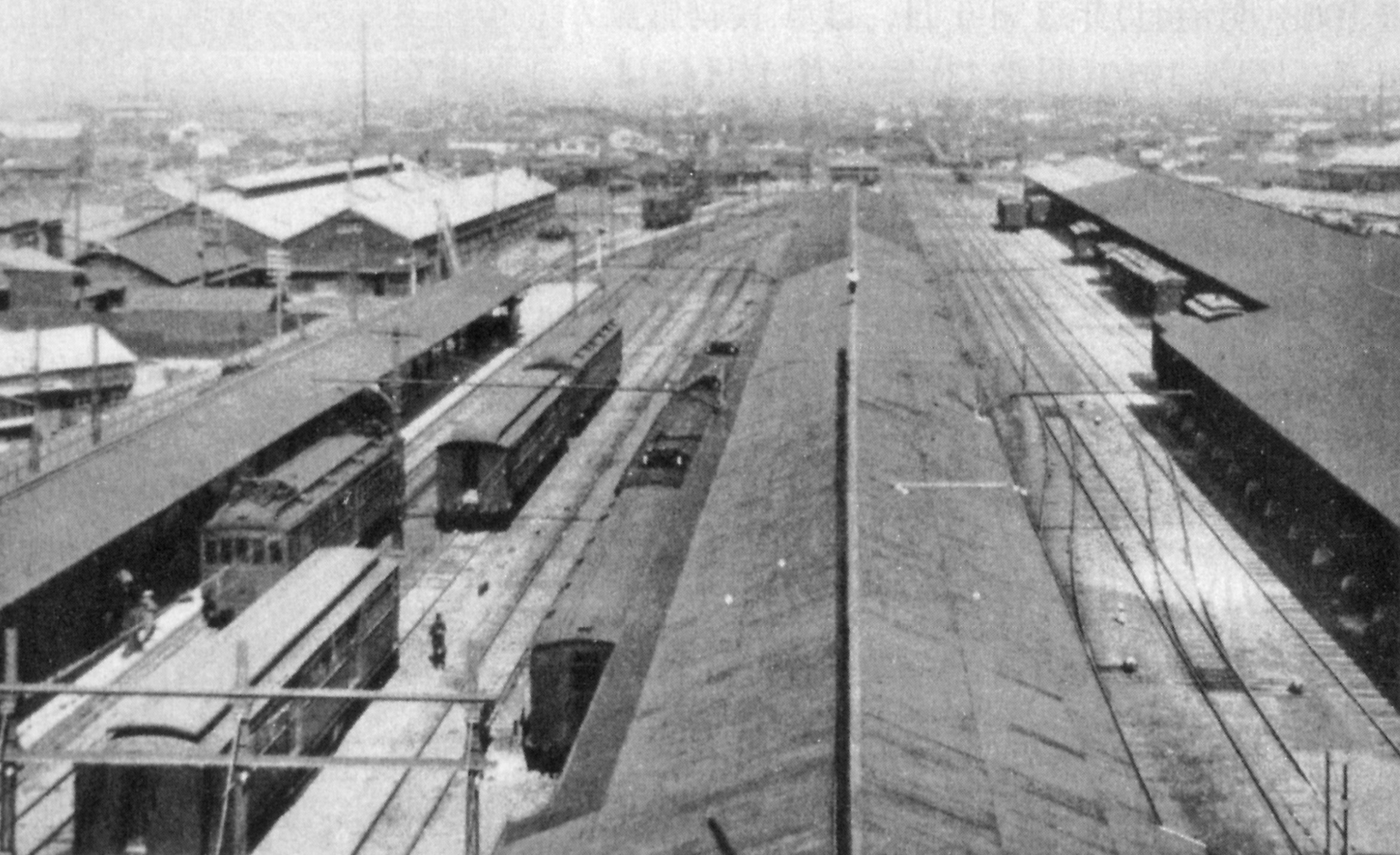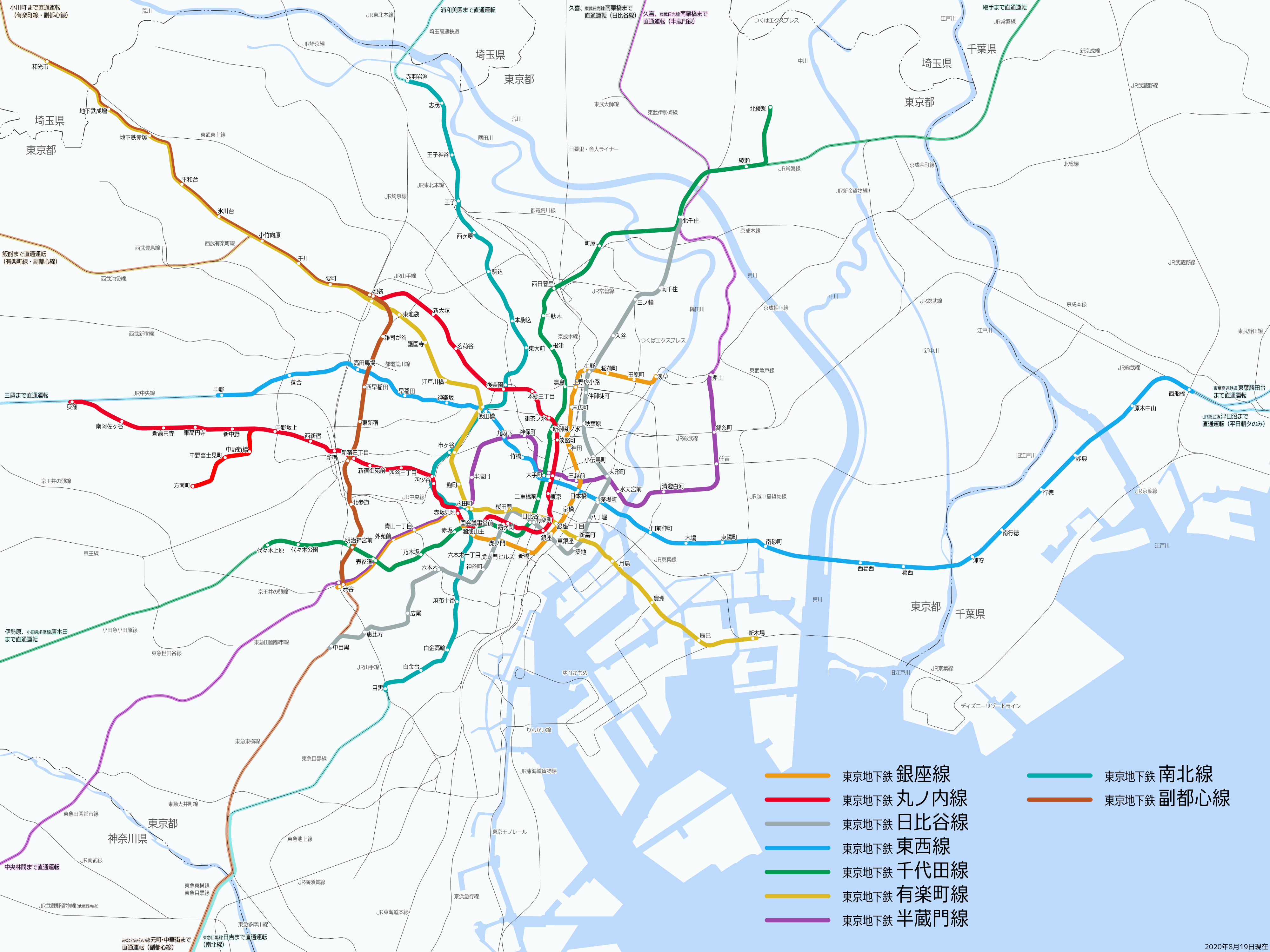|
Tokyo Toden
The or simply Toden, is the tram network of Tokyo, Japan. Of all its former routes, only one, the Tokyo Sakura Tram, remains in service. The Tokyo Metropolitan Bureau of Transportation operates the Toden. The formal legal name is ''Tokyo-to Densha.'' Its nickname, "Toden," distinguished it from the "Kokuden" (the Japanese National Railways electrified lines). The network had a track gauge of , except for the former Seibu Railway lines which were . __TOC__ History At its peak, the Toden system boasted 41 routes with of track. However, the increase in reliance on automobile traffic resulted in reductions in ridership, and from 1967 to 1972, of track were abandoned as the Bureau changed its emphasis to bus and subway modes of transportation. *1903: The Tokyo Horse-drawn Railway changed its motive power to electricity and, under the name Tokyo Electric Railway (or Tōden, 東電) commenced operations between and . *1903: The Tokyo Urban Railway (or Gaitetsu, 街鉄) began oper ... [...More Info...] [...Related Items...] OR: [Wikipedia] [Google] [Baidu] |
Tram
A tram (also known as a streetcar or trolley in Canada and the United States) is an urban rail transit in which Rolling stock, vehicles, whether individual railcars or multiple-unit trains, run on tramway tracks on urban public streets; some include segments on segregated Right-of-way (property access), right-of-way. The tramlines or tram networks operated as public transport are called tramways or simply trams/streetcars. Because of their close similarities, trams are commonly included in the wider term ''light rail'', which also includes systems separated from other traffic. Tram vehicles are usually lighter and shorter than Main line (railway), main line and rapid transit trains. Most trams use electrical power, usually fed by a Pantograph (transport), pantograph sliding on an overhead line; older systems may use a trolley pole or a bow collector. In some cases, a contact shoe on a third rail is used. If necessary, they may have dual power systems—electricity in city stre ... [...More Info...] [...Related Items...] OR: [Wikipedia] [Google] [Baidu] |
Kanda, Tokyo
is an area in northeastern Chiyoda, Tokyo, Japan. It encompasses about thirty neighborhoods. Kanda was a ward prior to 1947. When the 35 Special wards of Tokyo, wards of Tokyo were reorganized into 23, it was merged with Kojimachi to form the modern Chiyoda. Kanda, together with Nihonbashi and Kyōbashi, Tokyo, Kyobashi, is the core of Shitamachi, the original downtown center of Edo-Tokyo, before the rise of newer secondary centers such as Shinjuku and Shibuya. It is home to the Kanda Myojin (Shinto) Jinja (shrine), shrine, devoted to the ancient rebel Taira no Masakado, who led an uprising against the central government during the Heian period with the aim of establishing himself as "Shinnō" (New Emperor) of an eastern Court. In the Edo period, the shrine's festival was one of the three most noted in the city. It is also home to the "Mausoleum of Confucius at Yushima", a temple dedicated to Confucianism. Kanda is the home of the Tokyo Resurrection Cathedral which was buil ... [...More Info...] [...Related Items...] OR: [Wikipedia] [Google] [Baidu] |
Ueno Station
is a major railway station in Tokyo's Taitō ward. It is the station used to reach the Ueno district and Ueno Park—which contains Tokyo National Museum, The National Museum of Western Art, Ueno Zoo, Tokyo University of the Arts and other famous cultural facilities. A major commuter hub, it is also the traditional terminus for long-distance trains from northern Japan, although with the extension of the Shinkansen lines to Tokyo Station this role has diminished in recent years. A similar extension of conventional lines extended Takasaki Line, Utsunomiya Line and Jōban Line services to Tokyo Station via the Ueno-Tokyo Line in March 2015, using existing little-used tracks and a new viaduct; the Ueno-Tokyo Line connects these lines with the Tōkaidō Main Line, allowing through services to Shinagawa, Yokohama, Odawara and Atami stations. Ueno Station is close to Keisei Ueno Station, the Tokyo terminus of the Keisei Main Line to Narita Airport Station. Lines This station ... [...More Info...] [...Related Items...] OR: [Wikipedia] [Google] [Baidu] |
Narihirabashi Station
is a railway station on the Tobu Skytree Line in Sumida, Tokyo, Japan, operated by the private railway operator Tobu Railway. It is adjacent to the Tokyo Skytree and Skytree Town redevelopment, and was formerly known as Narihirabashi Station. Lines Tokyo Skytree Station is served by the Tobu Skytree Line from , and is 1.1 km from the line's Asakusa terminus. Station layout The station consists of one island platform serving two tracks. Platforms File:東武鉄道 とうきょうスカイツリー駅.JPG, Platform 2 looking east, May 2012 File:東武鉄道 とうきょうスカイツリー駅 入出口.jpg, The station entrance in May 2012 Adjacent stations All kinds of the limited express excluding ''Skytree Liner'' and ''Urban Park Liner'' stop at Hikifune Station as the next or previous station at only the morning and evening. At the noon, all of the limited express except ''Skytree Liner'' and ''Urban Park Liner'' stop at Kita-Senju Station as the next or p ... [...More Info...] [...Related Items...] OR: [Wikipedia] [Google] [Baidu] |
Tobu Railway
is a Japanese commuter railway and ''keiretsu'' holding company in the Greater Tokyo Area as well as an intercity and regional operator in the Kantō region. Excluding the Japan Railways Group companies, Tobu's rail system is the second longest in Japan after Kintetsu Railway, Kintetsu. It serves large portions of Saitama Prefecture, Gunma Prefecture and Tochigi Prefecture, as well as northern Tokyo and western Chiba Prefecture. The Tobu Railway Company is listed in the First Section of the Tokyo Stock Exchange and is a constituent of the Nikkei 225 index. The Tobu corporate group is also engaged in road transportation (bus/taxi), real estate, and retail. It is the owner of the Tokyo Skytree, the third tallest tower in the world. The company is a member of the Fuyo Group ''keiretsu''. The name "Tobu" is formed from the kanji for and , the initial area served. History Tobu is one of the oldest railway companies in Japan. It was established in November 1897 and began operation ... [...More Info...] [...Related Items...] OR: [Wikipedia] [Google] [Baidu] |
Keihin Electric Express Railway
(), also known as or, more recently, , is a private railroad that connects inner Tokyo to Kawasaki, Yokohama, Yokosuka and other points on the Miura Peninsula in Kanagawa Prefecture. It also provides rail access to Haneda Airport in Tokyo. means the - area. The company's railroad origins date back to 1898, but the current company dates to 1948. The railway pioneered Kantō region's first electric train and the nation's third, after Hanshin Electric Railway and Nagoya Electric Railway ( Meitetsu) with the opening of a short long section of what later became the Daishi Line in January 1899. It is a member of the Fuyo Group and has its headquarters in Yokohama. The company changed its English name from Keihin Electric Express Railway Co., Ltd. to Keikyu Corporation on 21 October 2010. Trains on the Main Line have a maximum operating speed of , making it the third fastest private railroad in the Tokyo region after the Keisei ''Skyliner'' and the Tsukuba Express. The ... [...More Info...] [...Related Items...] OR: [Wikipedia] [Google] [Baidu] |
Tokyo Toden Map
Tokyo, officially the Tokyo Metropolis, is the capital of Japan, capital and List of cities in Japan, most populous city in Japan. With a population of over 14 million in the city proper in 2023, it is List of largest cities, one of the most populous urban areas in the world. The Greater Tokyo Area, which includes Tokyo and parts of six neighboring Prefectures of Japan, prefectures, is the most populous metropolitan area in the world, with 41 million residents . Lying at the head of Tokyo Bay, Tokyo is part of the Kantō region, on the central coast of Honshu, Japan's largest island. It is Japan's economic center and the seat of the Government of Japan, Japanese government and the Emperor of Japan. The Tokyo Metropolitan Government administers Tokyo's central Special wards of Tokyo, 23 special wards, which formerly made up Tokyo City; various commuter towns and suburbs in Western Tokyo, its western area; and two outlying island chains, the Tokyo Islands. Although most of the w ... [...More Info...] [...Related Items...] OR: [Wikipedia] [Google] [Baidu] |
Tokyo Metro
The Tokyo Metro () is a major rapid transit system in Tokyo, Japan, operated by the #Organization, Tokyo Metro Co. With an average daily ridership of 6.52 million passengers (as of 2023), the Tokyo Metro is the larger of the Tokyo subway, two subway operators in the city, the other being the Toei Subway, with 2.85 million average daily rides. Organization Tokyo Metro is operated by , a joint-stock company jointly owned by the Government of Japan and the Tokyo Metropolitan Government. The company, founded as a part of then-Prime Minister Junichiro Koizumi's policy of converting statutory corporations into Joint-stock company, joint-stock companies, replaced the , commonly known as Eidan or TRTA, on April 1, 2004. TRTA was administered by the Ministry of Land, Infrastructure and Transport (Japan), Ministry of Land, Infrastructure and Transport, and jointly funded by the national and metropolitan governments. It was formed in 1941 as a part-nationalization of the Tokyo Undergrou ... [...More Info...] [...Related Items...] OR: [Wikipedia] [Google] [Baidu] |
Suginami, Tokyo
is a Special wards of Tokyo, special ward in the Tokyo, Tokyo Metropolis in Japan. The ward refers to itself as Suginami City in English. As of June 1, 2022, Suginami has an estimated population of 588,354 and a population density of 17,274 persons per km2. The total area is 34.06 km2. Geography Suginami occupies the western part of the ward area of Tokyo. Its neighbors include these special wards: to the east, Shibuya, Tokyo, Shibuya and Nakano, Tokyo, Nakano; to the north, Nerima, Tokyo, Nerima; and to the south, Setagaya, Tokyo, Setagaya. Its western neighbors are the cities of Mitaka, Tokyo, Mitaka and Musashino, Tokyo, Musashino. The Kanda River passes through Suginami. The Zenpukuji river originates from Zenpukuji Park in western Suginami, and the Myōshōji River originates in Myōshōji Park, to the north of Ogikubo station. History The name Suginami dates back to the early Edo period and is a shortened version of ''Suginamiki'' ("avenue of Cryptomeria, cedars"). ... [...More Info...] [...Related Items...] OR: [Wikipedia] [Google] [Baidu] |
1964 Summer Olympics
The , officially the and commonly known as Tokyo 1964 (), were an international multi-sport event held from 10 to 24 October 1964 in Tokyo, Japan. Tokyo had been awarded the organization of the 1940 Summer Olympics, but this honor was subsequently passed to Helsinki due to Japan's invasion of China, before ultimately being cancelled due to World War II. Tokyo was chosen as the host city during the 55th IOC Session in West Germany on 26 May 1959. The 1964 Summer Games were the first Olympics held in Asia, and marked the first time South Africa was excluded for using its apartheid system in sports. Until 1960, South Africa had fielded segregated teams, conforming to the country's racial classifications; for the 1964 Games the International Olympic Committee demanded a multi-racial delegation to be sent, and after South Africa refused, they were excluded from participating. The country was, however, allowed to compete at the 1964 Summer Paralympics, also held in Tokyo, its ... [...More Info...] [...Related Items...] OR: [Wikipedia] [Google] [Baidu] |
Shinjuku, Tokyo
, officially called Shinjuku City, is a special ward of Tokyo, Japan. It is a major commercial and administrative center, housing the northern half of the busiest railway station in the world ( Shinjuku Station) as well as the Tokyo Metropolitan Government Building, the administrative center of the Tokyo Metropolitan Government. , the ward has an estimated population of 346,235 and a population density of 18,232 people per km2. The total area is 18.23 km2. Since the end of World War II, Shinjuku has become a major secondary center of Tokyo ( ''fukutoshin''), rivaling the original city center in Marunouchi. "Shinjuku" is also commonly used to refer to Shinjuku Station. The southern half of this area and majority of the station are in fact located in the neighboring Shibuya ward. History In 1634, during the Edo period, as the outer moat of the Edo Castle was built, a number of temples and shrines moved to the Yotsuya area on the western edge of Shinjuku. In 1698, Nai ... [...More Info...] [...Related Items...] OR: [Wikipedia] [Google] [Baidu] |
Trolley Bus
A trolleybus (also known as trolley bus, trolley coach, trackless trolley, trackless tramin the 1910s and 1920sJoyce, J.; King, J. S.; and Newman, A. G. (1986). ''British Trolleybus Systems'', pp. 9, 12. London: Ian Allan Publishing. .or trolleyDunbar, Charles S. (1967). ''Buses, Trolleys & Trams''. Paul Hamlyn Ltd. (UK). Republished 2004 with or 9780753709702.) is an electric bus that draws power from dual overhead wires (generally suspended from roadside posts) using spring-loaded or pneumatically raised trolley poles. Overhead line#Parallel overhead lines, Two wires, and two trolley poles, are required to complete the electrical circuit. This differs from a tram or streetcar, which normally uses the track as the return path, needing only one wire and one pole (or pantograph (transport), pantograph). They are also distinct from other kinds of Battery electric bus, electric buses, which usually rely on Automotive battery, batteries. Power is most commonly supplied as 600-volt ... [...More Info...] [...Related Items...] OR: [Wikipedia] [Google] [Baidu] |









